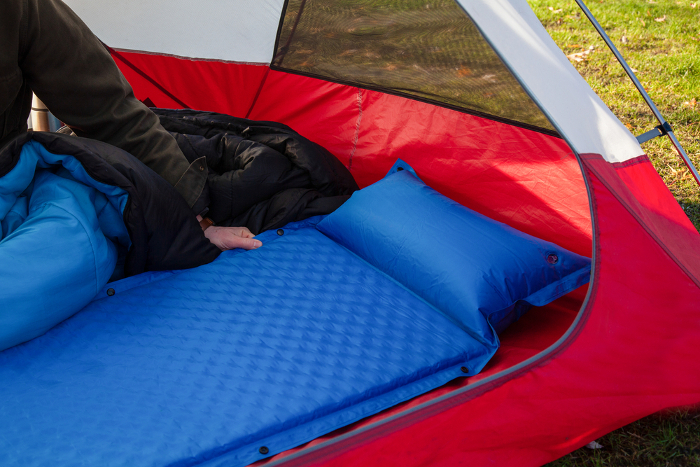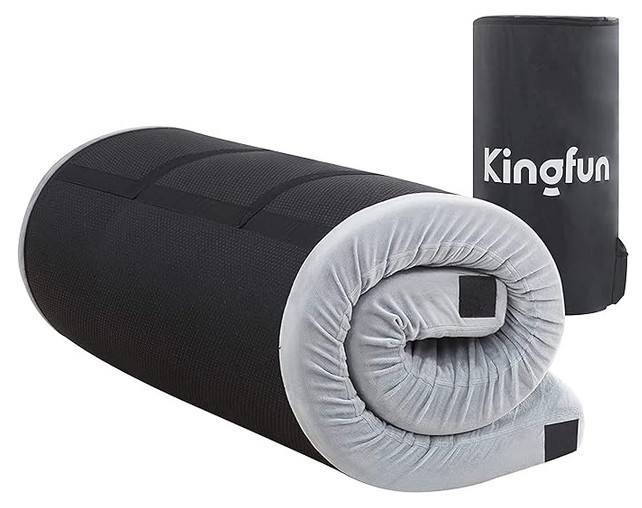If you’ve been following our previous discussion on ‘Camping Cots vs Sleeping Pads,’ you’re already familiar with the different options available. Now, let’s delve deeper into the comparison between inflatable and foam sleeping pads.
When it comes to choosing the perfect sleeping pad for your family camping adventures, it can be challenging to decide between inflatable and foam options. In this article, we will explore the key factors that differentiate these two types of sleeping pads, including weight, size, comfort, durability, and warmth. By understanding these differences, you will be well-equipped to make an informed decision based on your specific needs and preferences.
So, get ready to enhance your camping experience with the ideal sleeping pad by your side! Let’s dive into the comparison between inflatable and foam sleeping pads.
Differences Between Inflatable and Foam Sleeping Pads
In terms of comfort, inflatable sleeping pads are generally considered to be more comfortable than foam pads. This is because they are able to provide more cushioning and support, and can be adjusted to the desired firmness. Foam pads, on the other hand, tend to be firmer and less plush.
When it comes to durability, foam sleeping pads have the upper hand. They are less prone to punctures or leaks, making them more durable in the long run. Inflatable pads, while they can provide excellent comfort, are more susceptible to damage and may require patching or replacement.
In terms of warmth and insulation, both inflatable and foam pads offer good insulation from the ground. However, inflatable pads have the advantage of being able to trap air more effectively, providing better insulation and warmth. Foam pads, while they also provide insulation, may not be as effective in colder temperatures.
When considering weight and packed size, inflatable pads are generally lighter and more compact than foam pads. This makes them a preferred choice for backpackers or anyone looking to minimize their pack weight and save space.
Finally, there is the aspect of price and value. Foam sleeping pads tend to be more affordable compared to inflatable pads. However, the higher cost of inflatable pads is often justified by the added comfort and convenience they offer. It ultimately comes down to personal preference and budget.

Comfort of Inflatable vs Foam Sleeping Pads
When considering the comfort of inflatable and foam sleeping pads, it’s important to take into account the differences between the two options.
Inflatable sleeping pads provide a more cushioned and comfortable sleeping surface, while foam sleeping pads may feel firmer and less forgiving on uneven terrain.
The thickness and design of an inflatable sleeping pad contribute to its comfort level, whereas foam sleeping pads may not provide as much insulation or padding.
The comfort of the sleeping pad can greatly affect your quality of sleep during outdoor trips, so it’s crucial to choose the option that best suits your needs and preferences.
Keep in mind that comfort is subjective, and what works for one person may not work for another.
Durability
To compare the durability of inflatable and foam sleeping pads, consider their resistance to damage and longevity.
Inflatable sleeping pads are prone to punctures and leaks, requiring careful handling. The material used in inflatable sleeping pads can affect their durability.
On the other hand, foam sleeping pads are generally more durable and resistant to damage. They can withstand rough use and exposure to elements. This durability is important for long-term use and investment.
When it comes to serving others, a durable sleeping pad ensures that you have a reliable and comfortable sleeping surface during outdoor trips. You won’t have to worry about your sleeping pad getting damaged easily, allowing you to focus on enjoying your adventure.
Warmth and insulation
When considering the warmth and insulation of inflatable and foam sleeping pads, it’s important to understand the differences between the two options.
Inflatable sleeping pads offer better insulation and warmth in cold conditions due to their ability to trap more air. They’re suitable for high alpine and cold weather camping.
On the other hand, foam sleeping pads provide minimal insulation and may feel colder on the ground. They’re sufficient for summer and sea level camping.
It’s crucial to choose the right type of sleeping pad based on the climate and conditions you’ll be camping in. If you’re camping in colder climates, an inflatable sleeping pad would be the better choice for its superior insulation. However, if you’re camping in warmer climates, a foam sleeping pad would be sufficient.
Weight and Packed Size
If you’re comparing inflatable sleeping pads to foam sleeping pads, one important factor to consider is the weight and packed size. Inflatable sleeping pads are generally lighter than foam sleeping pads, making them a better option for those who prioritize lightweight gear.
Foam sleeping pads, on the other hand, tend to be bulkier and heavier, taking up more space in your backpack. When deflated, inflatable sleeping pads can be compacted to a smaller size, making them more packable and easier to fit inside your backpack. Foam sleeping pads, however, may be more difficult to squeeze into a limited space.
Price and Value
Now let’s talk about the price and value differences between inflatable and foam sleeping pads.
When it comes to price, foam sleeping pads are generally more affordable, ranging from $20 to $45. On the other hand, inflatable sleeping pads can be more expensive, especially high-end models with additional features, which can cost over $150.
In terms of value, foam sleeping pads are known for their durability and resistance to damage, making them a good long-term investment. Inflatable sleeping pads, while prone to punctures and leaks, offer better insulation and warmth in cold conditions, making them valuable for camping in high alpine or cold weather.
Ultimately, the choice between inflatable and foam sleeping pads will depend on your budget, durability needs, and the specific camping conditions you anticipate.
Pros and Cons of Inflatable Pads
Using inflatable pads has its pros and cons when it comes to camping and outdoor sleeping.
On the positive side, inflatable pads offer a comfortable sleeping surface, providing cushioning and insulation for a good night’s sleep. They’re also warm and suitable for three seasons, making them ideal for various terrains and conditions.
Inflatable pads can be repaired with patch kits, extending their lifespan. Additionally, they’re less bulky than closed-cell foam pads, saving valuable space in your backpack.
However, there are some drawbacks to consider. Inflatable pads can fail, requiring time to inflate and deflate. They can also be expensive, and extra care and maintenance are needed to prevent punctures and tears. Moreover, they may not provide adequate protection against sharp objects.
Pros and Cons of Foam Sleeping Pads
Foam sleeping pads offer their own set of advantages and disadvantages when it comes to camping and outdoor sleeping.
On the positive side, foam pads are lightweight, making them easier to carry during your outdoor adventures. They’re also generally more affordable compared to inflatable pads, providing a cost-effective option. Foam pads don’t require any setup or takedown time, allowing you to quickly get in and out of your sleeping area.
However, there are some downsides to consider. Foam pads are less warm and comfortable compared to inflatable pads. They may also get caught on things and are only suitable for one season. Additionally, foam pads may require replacement when the nodes flatten out over time.

Overall Considerations
When considering inflatable sleeping pads vs foam sleeping pads, several factors should be taken into account.
Firstly, the weight and packed size of the sleeping pad will affect portability and the space it takes up in your backpack. Inflatable sleeping pads are generally lighter and more compact when deflated, making them a better choice for those concerned with weight and backpack space.
Secondly, comfort is subjective but can greatly impact your sleep quality during outdoor trips. Inflatable sleeping pads provide a more cushioned and comfortable sleeping surface, while foam sleeping pads may feel firmer and less forgiving on uneven terrain.
Additionally, durability is important for long-term use and resistance to damage. Foam sleeping pads are generally more durable and resistant to punctures, while inflatable sleeping pads require careful handling to avoid leaks.
Lastly, warmth is crucial for staying comfortable in colder climates. Inflatable sleeping pads offer better insulation and warmth, while foam sleeping pads may not provide as much insulation.
Consider your personal preferences and specific needs when choosing between inflatable and foam sleeping pads.
Conclusion
In conclusion, when choosing between inflatable and foam sleeping pads, it ultimately comes down to personal preference and specific camping needs.
Inflatable pads offer lightweight portability and customizable comfort, but may be less durable.
Foam pads provide excellent insulation and durability, but can be bulkier and less packable.
Consider factors such as weight, packed size, comfort, durability, and warmth to determine which type of sleeping pad is best suited for your outdoor adventures.
